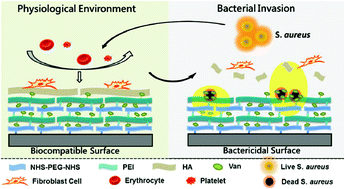Bacterial adaptability of enzyme and pH dual-responsive surface for infection resistance†
Abstract
A major challenge in antibacterial surface preparation is the elaborated implementation of controlled antibacterial agent delivery on demand, typically at appropriate concentrations and sites, which can be an efficient way to lower bacteria resistance and improve therapy effectiveness. Herein, we present a bacterial hyaluronidase (HAase) and pH dual-responsive antimicrobial surface, which is constructed by sequential layer-by-layer (LbL) assembly of NHS-PEG-NHS (PEG-bis(succinimidyl succinate)) and PEI (polyethylenimine), immobilization of antibiotic vancomycin (Van) by an acid-labile β-carboxylic linker and electrostatic adsorption of HA. The HA upper layer can endow the multilayer surface with excellent biocompatibility under normal physiological conditions. Once bacteria invade, the secreted HAase specifically enzymolyzes the HA layer, and then the bound Van will be released in response to the bacteria-triggered local acidification to eliminate bacteria. Our work provides a versatile strategy in the design of a smart antibacterial surface with controlled antibacterial agent delivery, implying great potential for application in infection-resistant medical devices.



 Please wait while we load your content...
Please wait while we load your content...